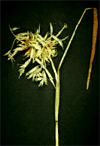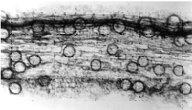Reports on Plant Diseases |
| RPD No. 122 -
Downy Mildew of Small Grains |
August
1989 |
[ Symptoms
] [ Disease Cycle ] [ Control
]
|
Downy mildew or crazy top of wheat, oats, barley, and rye (also
of corn, sorghum, rice, and a large number [about 140] of annual
and perennial cultivated and wild grasses) is caused by the fungus
Sclerophthora macrospora. Among perennial grasses, species of bentgrasses
(Agrostis spp), bluegrasses (Poa spp), bromegrasses Bromus spp),
canarygrasses (Pharis spp), St. Augustinegrasses (Stenotaphrum spp),
and wheatgrasses (Agropyron spp) are likely reservoirs for the downy
mildew fungus. The disease occurs all over the world. It is widespread
but sporadic in Illinois.
Downy mildew occurs only in localized areas of fields where seedlings
have been growing in waterlogged soil. Infected plants are most
common in flooded areas near ditches and lowlands where the Sclerophthora
fungus commonly occurs on other host plants.
Downy mildew is not a major disease of cereal plants in Illinois.
However, it may become destructive in individual fields when the
soil is saturated for 24 hours or longer within several weeks after
planting. Spots within a field may have dead plants in the center,
surrounded by plants with a variety of symptoms.
|

Figure
1. Oat panicle deformed by downy mildew (T.H. Bowyer photo).
|
Back to Top
Symptoms
Downy mildew produces various symptoms, depending on the severity
of the disease. The symptoms may closely resemble those produced
by an excessive concentration of 2,4-D or other phenoxy herbicide.
Affected small-grain or grass plants often tiller excessively.
Many of the tillers grow only a few inches before they wither, turn
brown, and die. Such plants appear as dense, dead clumps. Diseased
plants may appear somewhat stunted to severely dwarfed and deformed
with short, thickened or warty leaves that need to be stiff and
upright. The upper leaves also may be twisted and curled. Some leaves
will have yellow stripes, or will turn almost completely yellow
and fleshy. Such affected plants rarely head-out. Some may die prematurely;
others may remain green a few days longer than healthy plants.
The most characteristic symptoms are the proliferation of florets
and the development of distorted, twisted, and abnormally large
panicles (Figures 1 and 2) or heads (Figure 3). When downy mildew
infects wheat, the heads have a more open appearance than healthy
heads, and the chaff may be fleshy and green. The beards of bearded
wheats are distorted and abnormally long (Figure 3, left). Diseased
heads yield no viable grain. The stems (culms) below the affected
heads are often thick and deformed. A virus carried by the fungus
may influence the expression of symptoms in host plants.
|

Figure
2. Oat plants variously distorted by downy mildew
|
Back to Top
Disease Cycle
The downy mildew fungus produces a large number of round, pale
yellow, smooth-walled resting spores (oospores) within infected,
senescing leaf, glume, and culm tissue (Figure 4). Thee fungal structures
are best seen with a light microscope in decolorized leaf tissues
stained with acid fuchsin. The thick-walled oospores may persist
in dead host tissue for several years and are released into the
soil when diseased tissues decay. Oospores are carried from one
field to another in diseased plant residues and soil, in seed grain,
and by the wind, surface runoff water, and tillage equipment.
The oospores germinate in water or saturated soil to produce lemon-shaped
sporangia (conidia). Within an hour or two of formation the sporangia
usually liberate 30 to 90 motile zoospores.
The zoospores are capable of swimming short distances in water
before settling down and forming slender germ tubes that penetrate
the host tissues of mostly seedling plants.
Following infection, the downy mildew fungus develops systemically
within the plant, becoming most abundant in actively growing tissue.
Sporangia are formed and infection occurs over a wide range of soil
temperatures (44 to 88 F or 6 to 31 C; optimum 50 to 77 F or 10
to 25 C).
The causal fungus is incapable of reproducing in the absence of
a host plant. The fungus must infect living plants each season–small
grains, grasses, corn, sorghums, or rice; however, oospores persist
and remain viable for several years.
Back to Top
|

Figure
3. Wheat heads abnormally enlarged and deformed by downy mildew
(University of Wisconsin photo).
|
|
Downy mildew is seldom severe enough in Illinois to warrant special
control measures. However, the following steps may be taken.
1. Where possible, provide for proper surface and subsurface soil
drainage. Plant in well-prepared soil. Rotation with noncereal crops
is beneficial.
2. Control all grassy weeds since they may serve as host plants.
3. Avoid low areas of fields that are likely to be flooded.
4. Grain to be used for seed should be thoroughly cleaned by fanning
to remove all fragments of diseased tissue and lightweight kernels.
5. Whenever possible, select seed from fields known to be disease-free.
Very little is known about the relative resistance of small-grain
varieties to downy mildew. Seed treatment has no effect.
Back to Top
|

Figure
4. Oospores of the downy mildew fungus, Sclerophthora macrospora,
embedded in oat leaf tissue.
|
|
For further information concerning diseases of crucifers
and other vegetables, contact Mohammad Babadoost, Extension Specialist in Fruit
and Vegetable Pathology, Department of Crop Sciences, University of Illinois
at Urbana-Champaign.
University of Illinois Extension provides equal
opportunities in programs and employment.
|



